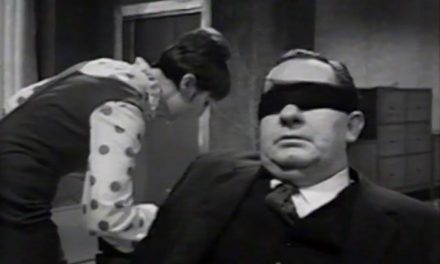If there is something ultimately distinctive about television it has to be in its strange handling of time and in our apprehension of this fact. I don’t mean merely its ability to transmit live images, or its collusion with the rhythms and seasonal adjustments of the local and national everyday, although its relations with these things is certainly odder than is usually acknowledged. What I have in mind is more to do with its prominent quality of adhesion to what Stanley Cavell calls, in relation to film, ‘the moods of faces and motions and settings, in their double existence as transient and as permanent’ (Rothman, ix); that is to say how ‘sticky’ is the medium to the gossamer-thin brevity of the granularity of fashion, gesture, and moods of address so that, for example, we can all share in the shock of being faced with the recovery of archival footage of Jimmy Savile, not only because of the Gothic re-emergence of this creepy figure but, when we see it, his immersion in the textures and textiles, the haircuts, makeup, gestures and sounds of another time all humming profoundly with the banal but vital drumbeat of the Now. But at the same time such footage reminds us of change, not just that our views of him, and then, have changed, but that the material itself seems to have transformed before our eyes into something else.
Such (admittedly, strange) thoughts caught up with me viewing the early episodes of the second season of Homeland. For a few weeks I went around convinced that the title sequence was now different from that in the first season; it incorporated, so I thought, material from the first (which it does, but then, it always did), thereby internalising its history. Title sequences hold a particular fascination for me because of their relationship to the time of the shows: they not only regularly set the flavour and tone of a show, but have to be resilient to the repeated exposure to that show’s changing content over time. Some shows, such as Breaking Bad or American Horror Story incorporate the sound and visuals of the title sequence as emphatic punctuation that caps the end of the opening teaser; others, like Homeland, simply begin (perhaps, depending on distributor, after a ‘previously on…’). So they can be renewed in relation to a differing context of the particular episode. Think for example, about the title sequence for American Horror Story: Asylum, a brilliant versioning of its first season appropriation of the visual and audio style of the title sequence of Se7en, one that localises the style to its particular moods, motions and settings.

But Se7en’s title sequence can only ever introduce the feature film Se7en; American Horror Story: Asylum’s titles must stand up against a dozen or so episodes in which it is incorporated. The same material takes on, or is hospitable to, differing ways of taking it according to the specific intentions, or unfolding, of an episode. What I really want to be saying here, is that the same thing – the same textual content – seems to be different, is different, because of its changing comportment before our eyes. This might seem quite troubling because we are used to taking cultural objects as constructed – like houses – and as expressive of their time, and unchanging. What changes is, obviously, our view of them. But do they, can they, change too?
It was only after an astute student pointed out to me that the second season titles for Homeland were identical to the first (he was right) that I began to wonder about why I might have been so convinced, and whether in fact I was actually wrong. Because, although the titles are the same – in terms of shots and their juxtaposition with music and dialogue (rather than credits, which vary) – they are changed, and they are changed because our experience of the show, and the show, has changed. I’ve written elsewhere that I believe television, like a lot of art, exhibits a process of ruination, the decay that is also growth, it is the fragmentation that aspires to a whole. When I saw the titles to second season of Homeland (which, to mention Cavell again, has become a version of the remarriage genre) it seemed to me to be doing, in front of our eyes, this process of absorbing its own history, but what I was seeing was the changing valency of the imagery of history as it was anchored to the individual. For Homeland’s titles tell us a story of individual development in its picturing of the young Carrie watching television, playing trumpet, immersed in a private mediation of global history that is framed as a dream of individual development caught in the mysterious and incoherent demands of a nation state unsure of itself beyond theatrical gestures – like those of Louis Armstrong – to will, to resilience, to resolve. These ruins, these fragments, become whole in the show only to be torn apart again and again: the titles remind us of the possibility of development from child to adult, a journey from sleep to the CIA. They hint that behind the mask might lie something real, something awake. But in television’s handling of time, even this will be unravelled.

The mixing of archival footage and dialogue from the real world with the fictional development of a child to adult, and its framing as the dream of the woman who was that child – the child that absorbed both the theatrical gestures of the government and the realism of the artist – is evocative of our generalised trap of being both in the world of politics and privatised in our culture. This mixing up of personal psychology and national, mediated by television, history evokes a world estranged not only from itself, but from its everyday processes of mediation; doubtful for sure, as to the progress or prospects for love or community in the future. Homeland’s title aesthetic reminded me most strongly of the extraordinary auteur of British didactic documentary, Adam Curtis, in its blending of psychology and history. Curtis’s work, which is heavily dependent on television archival footage (juxtaposed with his unique appropriation of some of the best film soundtracks and those from pop culture) confronts us with the ruins, the fragments of the past, in all their living, present vitality, strung to the tune of the now, to their relevance to how we got here. The difference is that Homeland plays it – the relationship between time, history and the individual – through an individual consciousness, whereas Curtis’s work bleeds that effect out toward the entirety of society. Nonetheless, Homeland’s titles, like television’s handling of time as a whole, aspire to that same sense of conveying how we were as a calibrating marker of what we are.
Jason Jacobs is Reader in Cultural History in the School of English, Media Studies and Art History, University of Queensland. He is author of The Intimate Screen and Body Trauma TV. He is currently working on an Australian Research Council funded project called ‘Worldwide: the history of the commercial arm of the BBC’. His BFI TV Classic on Deadwood has just been published. He is writing a book on David Milch for the Manchester University Press Television Series and is co-editor with Steven Peacock of the forthcoming collection Television: Aesthetics and Style (Continuum).





